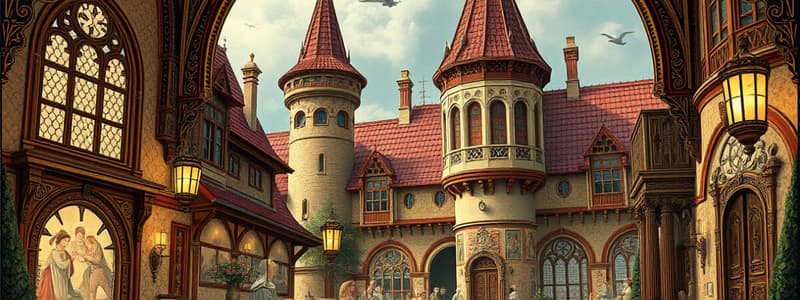Podcast
Questions and Answers
What time period is referred to as the Middle Ages?
What time period is referred to as the Middle Ages?
- 300-700
- 1000-1500
- 500-1500 (correct)
- 800-1200
What was the Dark Ages?
What was the Dark Ages?
A period that included political, social and economic decline, isolation from advanced civilizations, many invaders, slow trade, poor education and empty cities.
Who were the Franks?
Who were the Franks?
One of the Germanic tribes that invaded the Roman Empire, mostly farmers and herders governed by kings.
Who was Clovis?
Who was Clovis?
Muslims created an empire that threatened European Christianity.
Muslims created an empire that threatened European Christianity.
What did Charles Martel do?
What did Charles Martel do?
What was the outcome of the Battle of Tours?
What was the outcome of the Battle of Tours?
Who was Charlemagne?
Who was Charlemagne?
What did Pope Leo III do for Charlemagne?
What did Pope Leo III do for Charlemagne?
What was the Treaty of Verdun?
What was the Treaty of Verdun?
Who were the Magyars?
Who were the Magyars?
What were the Vikings known for?
What were the Vikings known for?
How did the culture of Germanic tribes differ from Roman culture?
How did the culture of Germanic tribes differ from Roman culture?
What was the significance of feudalism?
What was the significance of feudalism?
What obligations did lords have to their vassals?
What obligations did lords have to their vassals?
What role did monasteries play in medieval life?
What role did monasteries play in medieval life?
What was the effect of excommunication?
What was the effect of excommunication?
What contributions did monks and nuns make to their communities?
What contributions did monks and nuns make to their communities?
In what way did the growth of the middle class affect towns and cities?
In what way did the growth of the middle class affect towns and cities?
What were guilds?
What were guilds?
How did Christianity spread through Europe in the early Middle Ages?
How did Christianity spread through Europe in the early Middle Ages?
What was the impact of the Iron Plow?
What was the impact of the Iron Plow?
What is the Three Field System?
What is the Three Field System?
Study Notes
The Middle Ages Overview
- Time period from 500 to 1500, bridging ancient and modern times.
- Characterized by the "Dark Ages" (500-1000), marked by decline in political, social, and economic structures.
Key Groups and Leaders
- The Franks: Germanic tribe, primarily farmers and herders, led by kings.
- Clovis: King of the Franks who conquered France in 486 and converted to Christianity, gaining the Pope’s support.
- Charles Martel: Leader of the Franks, famously rallied troops at the Battle of Tours.
- Charlemagne: Grandson of Charles Martel, king from 768, expanded the Frankish Empire, fought invaders, and sought to revive education.
Major Conflicts and Agreements
- Muslims: Believers of Islam who posed a threat to Christianity, halted by the Battle of Tours in 732.
- Treaty of Verdun: Agreement among Charlemagne’s grandsons that divided the empire into three regions.
- Invasions: Viking, Muslim, and Magyar invasions created chaos, leading to the rise of feudalism for protection.
Feudal System
- Feudalism: Political structure where lords granted land (fiefs) to vassals in exchange for military service and loyalty.
- Social Hierarchy: Monarchs, powerful lords, vassals, and peasants formed a strict hierarchy.
- Knights: Mounted warriors trained from a young age, adhering to chivalric codes of honor and bravery.
Manorial System
- Manors: Lords’ estates that encompassed multiple villages and agricultural lands, essential to the economy.
- Self-Sufficiency: Manors produced their own food and necessities; peasants had little knowledge of the outside world.
Church and Religion
- Monasteries and Convents: Centers for spiritual life and education, providing health services.
- Benedictine Rule: Established by St. Benedict, outlined vows of obedience, poverty, and purity for monks and nuns.
- Papal Supremacy: The pope's authority over secular leaders, influencing politics and governance.
Economic Developments
- Iron Plow: Improved agricultural efficiency by turning deeper soil.
- Three Field System: Agricultural method enhancing food production and soil fertility.
- Guilds: Organizations of workers in various trades, regulating quality and protecting members’ interests.
- Growth of Middle Class: Emerged from prosperous merchants and artisans, leading to increased urban development.
Significant Social Changes
- Anti-Semitism: Prejudice against Jews increased, prompting migrations to Eastern Europe and Muslim lands.
- Impact of Excommunication: The church's use of excommunication fortified its power through fear and loyalty among medieval communities.
- Women in the Middle Class: Benefited from economic opportunities in crafts, leading to greater success in business.
Cultural and Daily Life
- Daily Life for Peasants: Primarily labor-focused with minimal schooling, isolated within manorial systems.
- Tournaments: Mock battles for knights, enhancing their skills and chivalric values.
- Role of Friars: Monks who traveled to preach and assist the impoverished, contributing to community reform.
This summary encapsulates the essential points of the Middle Ages, highlighting the socio-political structures, notable figures, and the impact of religion and economy on daily life.
Studying That Suits You
Use AI to generate personalized quizzes and flashcards to suit your learning preferences.
Description
Test your knowledge of the Middle Ages with these flashcards covering key terms and concepts from Chapter 7. Learn about significant events, eras such as the Dark Ages, and important tribes like the Franks. This quiz is a great way to reinforce your understanding of this pivotal period in history.




